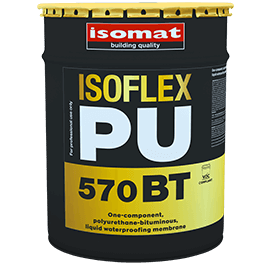One-component liquid waterproofing membrane based on polyurethane and bituminous resins. Shows elasticity and high mechanical strength and chemical resistance. It offers the following advantages:
- Forms a continuous, elastic and waterproof membrane, without seams or joints.
- Shows high mechanical strength.
- Has excellent adhesion to various substrates, such as concrete, cement screeds, wood, bituminous coatings, steel surfaces.
- Can be easily spot repaired.
- Applicable even to irregular substrates and in thick layers.
- Quick-drying time.
- Crack-bridging ability.
- Joint-sealing solution.
- Cost efficiency.
Certified according to EN 1504-2 and classified as a coating for surface protection of concrete. CE marked. ISOFLEX-PU 570 BT has been successfully tested by a third-party laboratory for resistance to root penetration, according to CEN/TS 14416:2014.
Suitable for waterproofing:
- Underground constructions, foundations.
- Green roofs, flower beds.
- Non-potable water tanks.
- Irrigation channels.
- Under tiles in kitchens, bathrooms, balconies, flat roofs and terraces, as long as quartz sand has been previously broadcast on its last layer.
- Under thermal insulation boards on flat roofs.
- In construction works, highways, tunnels, bridge decks, etc.
Substrate preparation
In general, the substrate must be dry (moisture content < 4%) and free of grease, loose particles, dust, etc.
1.1. Concrete substrates
Any existing cavities in the concrete should be repaired in advance. Severe cracks in the substrate must be locally primed and after 2-3 hours (depending on the weather conditions) must be sealed with the polyurethane sealants FLEX-PU-30 S or FLEX PU-50 S. Concrete and other porous surfaces should be treated with the polyurethane primer PRIMER-PU 100, with a consumption of 200-300 g/m2. Surfaces with moisture content > 4% should be primed with the special two-component polyurethane primer PRIMER-PU 140, with a consumption of 100-250 g/m2.
1.2. Smooth and non-absorbent substrates
Smooth and non-absorbent substrates, as well as bituminous membranes or old waterproofing layers, must be primed with the water-based epoxy primer EPOXYPRIMER-500, thinned with water up to 30% by weight. The product is applied with brush or roller in one coat.
Consumption: 150-200 g/m2.
1.3. Metal surfaces
Metal surfaces should be:
- Dry and clean.
- Free of grease, loose particles, dust, etc. that may impair adhesion.
- Free of rust or corrosion that may impair adhesion.
Having been prepared by brushing, rubbing, sandblasting, etc., and then thoroughly cleaned from dust, metal surfaces are primed with the EPOXYCOAT-AC anti-corrosion epoxy coating in one or two layers. EPOXYCOAT-AC is applied by roller, brush or spray. The second layer follows after the first has dried, but within 24 hours.
Consumption: 150-200 g/m2/layer
Application – Consumption
Before application, it is recommended to slightly stir ISOFLEX-PU 570 BT until a homogeneous mixture is formed. Extensive stirring should be avoided in order to prevent air entrapment.
a) Full-surface waterproofing
SIOFLEX-PU 570 BT is applied with a brush, roller or trowel 2-3 hours after priming and while PRIMER-PU 100 is still tacky.
Consumption: 1.3-2.0 kg/m2 in 2-3 layers, depending on the substrate.
b) Waterproofing under tiles
After applying ISOFlEX-PU 570 BT and while it is still fresh, quartz sand must be broadcast. The quartz sand must be completely dry.
Consumption of quartz sand: approx. 3kg/m2.
After 24 hours, any loose grains should be removed with a high suction vacuum cleaner. When installing ceramic tiles, it is recommended to use high performance polymer-modified tile adhesives, such as ISOMAT AK-22, ISOMAT-AK 23 XXl, ISOMAT AK-25, ISOMAT AK-ELASTIC, ISOMAT AK-MEGARAPID.




